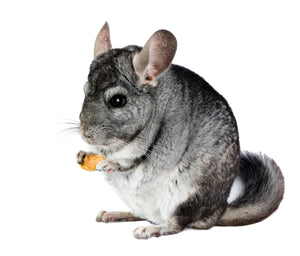 There are two types of chinchilla: The Lanigera, with a pointed nose and angular face, and the Chinchilla Brevicaudata, which is larger than the Lanigera with a thicker neck and shoulders but a short tail. There is a wide variety of coat colours available. All chinchillas have very thick, dense fur.
There are two types of chinchilla: The Lanigera, with a pointed nose and angular face, and the Chinchilla Brevicaudata, which is larger than the Lanigera with a thicker neck and shoulders but a short tail. There is a wide variety of coat colours available. All chinchillas have very thick, dense fur.
Housing
Chinchillas need a large metal cage with a solid metal base, which includes a climbing area, a sleeping box and a sand bath. As chinchillas enjoy climbing and jumping, a muli-level cage is ideal. The cage should not have a wire base or contain wire shelves as chinchillas are prone to bumblefoot – a condition which causes ulcers and skin cracking on the feet, which is exacerbated by unrelieved pressure on the animal’s feet.
Bedding
- Chinchillas will need plenty of woodchips or paper litter at the bottom of their cage as well as hay, which is important for their diet but also used as bedding material.
Feeding
- Chinchillas have a sensitive digestive system. They are herbivores and need a diet rich in fibre, so hay should always be readily available to them.
- The chinchilla diet is low in fat, so it is important to remember never to feed them sunflower seeds or peanuts as both of these are high in fat.
- Feed your chinchilla twice a day with a specially formulated chinchilla food mix, available from our shop.
- Water should always be readily available to your chinchilla and is best provided via a gravity-fed water bottle.
Handling
- Approach your chinchilla on the same level by crouching in front of it and allowing it to come to you by presenting the back of your hand for it to sniff.
- When you open your hand a tame chinchilla will climb on. Support its body weight with the other hand while lifting it up, and have it rest on your arm or against your body.
- Be careful not to squeeze your chinchilla too tightly as their ribs are easily broken.

